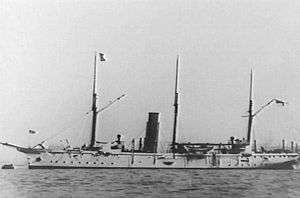Archer-class torpedo cruiser
 HMS Archer circa 1888 | |
| Class overview | |
|---|---|
| Name: | Archer class |
| Builders: | |
| Operators: |
|
| Preceded by: | Scout class cruiser |
| Succeeded by: | Marathon class cruiser |
| Built: | 1885–1886 |
| In commission: | 1890–1906 |
| Completed: | 8 |
| Lost: | 1 |
| Retired: | 7 |
| General characteristics | |
| Type: | 3rd class cruiser |
| Displacement: | 1,770 long tons (1,798 t) |
| Length: | 68.6 m (225 ft 1 in) |
| Beam: | 11 m (36 ft 1 in) |
| Draught: | 4.42 m (14 ft 6 in) |
| Installed power: | 4,500 hp (3,400 kW) at forced draught |
| Propulsion: | 2 cyl HDACE, 4 boiler [1] |
| Speed: | 17.5 knots at forced draught |
| Range: | 7,000 nmi (13,000 km) at 10 knots |
| Complement: | 176 |
| Armament: |
|
| Armour: |
|
The Archer class was a class of eight cruisers of the Royal Navy. Five ships were built at J & G Thomson in Glasgow while three ships were built at the Devonport Dockyard with all ships completed between 1885 and 1886. These ships mainly served in the British Empire's foreign fleets being on various stations throughout the north Atlantic, Pacific, and Indian oceans. Throughout their careers they were involved in a number of local conflicts including the Anglo-Zanzibar War, First Sino-Japanese War, and the Boxer Rebellion.[3]
Design
Third class cruisers of the Royal Navy, also known as torpedo cruisers, were designed to meet and defeat smaller torpedo boats while also being able to strike larger vessels with their own torpedoes. To this end they filled the role that would be soon taken over by early destroyer designs. The Archer class were enlarged derivatives of the earlier Scout class.
Fate
On November 10, 1890, HMS Serpent was caught in heavy storm off the northwest coast of Spain. The ship attempted to reach shelter but ran aground near Camariñas on the treacherous Costa da Morte of Galicia. All but three of her crew were killed. The resulting court martial investigating the loss of Serpent concluded that the ship had been lost as a result of a navigation error.[4] The seven other ships of the Archer class would quickly lose their usefulness to the Royal Navy as shipbuilding and design moved at a rapid pace around the turn of the century. All seven ships would be sold for scrap in 1905 and 1906.
Citations
- ↑ Brown, D.K. (2010) [1997]. Warrior to Dreadnought. Seaforth. p. 165. ISBN 978-1-84832-086-4.
- ↑ Gogin, I. (8/21/2017) ARCHER torpedo cruisers (1888-1891), http://www.navypedia.org/ships/uk/brit_cr_archer.htm
- ↑ Clowes pp. 430–431.
- ↑ "Aniversario del naufragio del "HMS Serpent"". El Ideal Gallego. 8 February 2015. Retrieved 2 October 2015.
References
- Clowes, William Laird (1903). The Royal Navy: A History From the Earliest Times to the Death of Queen Victoria: Volume VII. Sampson Low, Marston and Company.